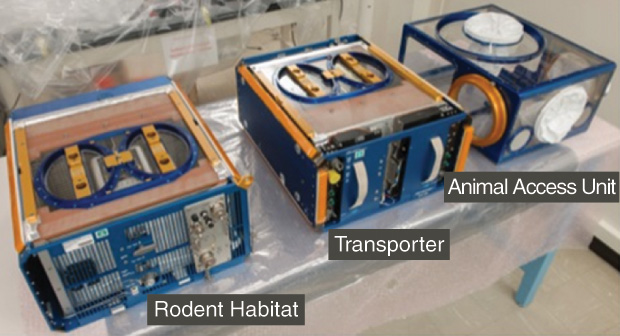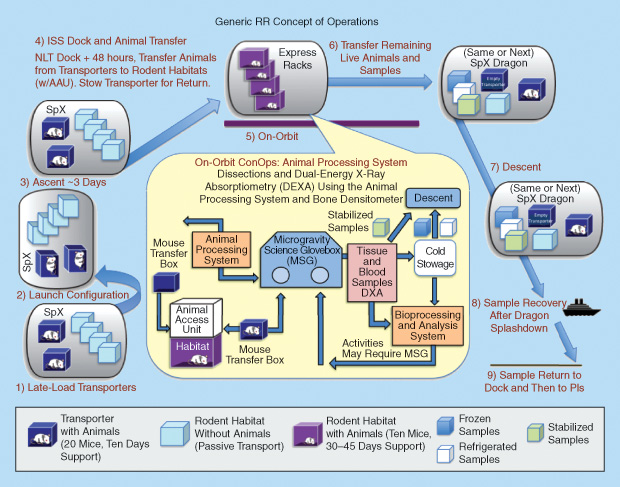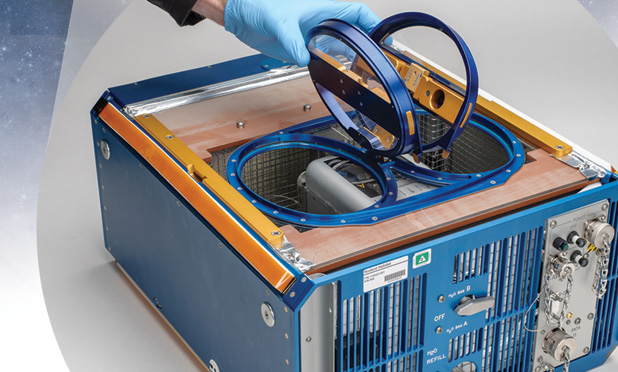Long-duration spaceflight has deleterious effects on organisms adapted to life in Earth’s gravity. For humans, some of these effects are relatively minor, rapidly resolved, and well understood. For example, going from Earth gravity to weightlessness can cause disorientation and nausea (space sickness), whereas returning to Earth after getting used to microgravity can cause orthostatic intolerance (various symptoms that manifest when standing but abate when sitting back down). Other effects of living in space are more persistent and potentially debilitating. Stemming from many organ systems responding to reduced gravity, these effects include cardiovascular and musculoskeletal alterations, neurovestibular and sensorimotor adaptation, immune dysfunction, delayed wound healing in soft tissues, and incomplete fracture repair in bones.
Moreover, the body’s responses to microgravity mimic the accelerated onset of health-related problems associated with aging and debilitating chronic human diseases on Earth, including osteoporosis, muscle wasting/atrophy, cardiovascular deconditioning, immunodeficiency, and increased susceptibility to infectious disease resulting from diminished adaptive immunity (immune dysfunction) or increased microbial capacity to cause disease (pathogenicity). These challenges in microgravity, coupled with access to well-characterized animal models, versatile flight hardware for animal habitation, high-fidelity analytical facilities, and crew resources on the International Space Station (ISS) U.S. National Lab, represent a unique and time-critical opportunity to accelerate scientific discovery and translational medical treatment for many human afflictions on Earth.
The Case for Using Model Organisms on the ISS
On Earth, animal research models are essential for understanding the onset and development of human disease, the discovery of disease mechanisms and therapy targets, and the testing of drugs to treat disease and promote recovery. Studying accelerated bone and muscle loss in space in collaboration with commercial partners will offer insight into disease mechanisms, help identify potential new drug targets, and enable preclinical evaluation of candidate therapeutics targeted to such diseases. These research pathways, if successful, could lead to new treatments for osteoporosis and muscle wasting caused by conditions such as muscular dystrophy, bed rest, aging, casting, spinal cord injury, cancer, and kidney failure.

To expand use of the ISS for research to address the mechanism of change in these organ systems and to develop countermeasures for microgravity’s effects and treatments for human disease, researchers will need to use established animal research models of human disease to integrate data from multiple studies. For this reason, NASA is developing an improved capability, the Rodent Research (RR) facility, to house animals onboard the ISS for experiments, initially for 30–60 days and eventually for durations of up to 180 days. The Center for the Advancement of Science in Space (CASIS) is working with NASA, commercial companies, academic institutions, U.S. government agencies, and international partners on the ISS to enable access to this facility for research in space with benefit on Earth.
The RR Facility
[accordion title=”Commercial Use of Space for Drug Development”]
Commercial development of new drugs also stands to benefit from spaceflight studies with rodents. Rodent models yield crucial preclinical efficacy and safety data that largely determine whether investments in clinical evaluations will be warranted. Spaceflight offers a unique disuse model that is free of any invasive surgical or immobilization techniques and has a precise start (launch) and stop (re-entry) time. Several companies have partnered with NASA and implementation partners to use this “extreme disuse” model on the Space Shuttle. Amgen (Thousand Oaks, California), for instance, flew shuttle experiments with Bioserve Space Technologies (Boulder, Colorado) on STS -108, STS -118, and STS -135 to investigate bone antiresorptive (osteoprotegerin), muscle-growth promoter (myostatin inhibitor), and bone-growth promoter (sclerostin inhibitor) drugs, respectively. In each experiment, significant bone and muscle loss occurred in only 12–13 days of spaceflight exposure—faster than ground-based disuse models—thus showing the utility of spaceflight as a unique model for drug testing. CASIS is working with pharmaceutical companies to build on this work in microgravity and expand use of the International Space Station U.S. National Lab for drug development (see [Reference 1]) and preclinical testing in cell lines and animal models.
References
- E. Roberge, “Crystal clear,” IEEE Pulse, vol. 5, no. 4, pp. 30–34, July/Aug. 2014.
[/accordion]
The RR facility offers the capability to perform biological research on the ISS with either rats or mice. The hardware design is based on the NASA Animal Enclosure Module used aboard the Space Shuttle to support 27 successful rodent flight experiments of up to 19 days duration (see “Commercial Use of Space for Drug Development”). Early flights of the RR facility to the ISS U.S. National Lab will allow support mission durations of 30–60 days using female mice. Later flights will support experiments of up to 180 days and will support male mice or rats and, eventually, even experiments requiring live animal return or in-orbit animal husbandry. The RR hardware system consists of a transporter to bring animals to the ISS on SpaceX Dragon supply flights and a habitat to house animals on the ISS. Below is a generic concept of operations for early missions (2014–2015) and later missions (2016 and beyond) for the RR hardware system.

RR Preparation and Transportation to the ISS
Although the launch site for the SpaceX Dragon capsule at Kennedy Space Center has laboratories and facilities for receiving, housing, and preparing animals, the principal investigator (PI) team will need to supply special equipment, procedures, and other experiment-specific considerations. Each RR mission can accommodate up to 40 mice (with a nominal body weight of 30 g each), which will be loaded into one of two transporters for integration into the Dragon capsule approximately 12 hours before launch. Each transporter can hold up to 20 mice in a common space, or the animals may be divided into two cages of up to ten mice each. Transportation to the ISS in the SpaceX Dragon capsule should take three to four days but could take as many as seven days. During ascent and berthing to the ISS, no video or real-time environmental data downlink is available, but recorded environmental data can be downloaded from the ISS after animals are delivered. Once the animals reach the ISS, the crew will remove the animals from the transporter units and transfer them into the habitat units in the ISS U.S. National Lab.
ISS RR Housing
One habitat unit will house up to ten mice for early flights. Each habitat can be divided into two cages that can hold five animals each. On later flights, it may be possible to house larger numbers of mice in each habitat. When rats are introduced, the number of rats will be fewer, potentially four to six in each habitat. Although animals may be separated into two cages within one habitat, the air and waste handling systems are shared. Scientists can monitor conditions in the habitat, such as temperature and relative humidity, but they cannot adjust them. Conditions in the habitat will correspond to conditions in the ISS cabin. The crew will visually assess animals’ food and water at regular intervals and can transfer animals to a second habitat if required, pending availability. Limited real-time video monitoring for health and status will be available for downlink and analysis by the PI team. Also, ground personnel can schedule video observation and light–dark cycles (including infrared lighting for video monitoring during the dark cycle).
ISS RR Capabilities
The Microgravity Science Glovebox (MSG) will enable dissections and other biological procedures requiring containment. Basic kits for general dissection, injection (with anesthetics for nonterminal procedures and materials to euthanize animals), and monitoring animal health will be available. The Techshot bone densitometer will be available for whole-body measurements. Experimental procedures, euthanasia, and general dissection can be conducted within the MSG; however, plans for any procedures performed on live animals must consider the MSG’s limited working environment and the challenges and constraints of performing experiments in microgravity. Chemical fixation and cold-storage resources to preserve tissue samples for return to Earth will also be available.
Sample Return
Although early ISS flight experiments will not be able to return live animals to Earth, live animal return may be available as early as 2016. Tissue samples, returned in frozen or chemically fixed form, will nominally be available to the PI team as soon as two to three days after splashdown of the Dragon capsule into the Pacific Ocean.
Ground-Control Experiments
NASA will support synchronous ground-based control-group experiments (housed in flight hardware in controlled environment chambers) and in normal vivarium conditions. If appropriate, ground-control experiments may be performed on an asynchronous time delay to allow controlling temperature and other parameters to closely follow flight conditions.
The Future of RR on the ISS
[accordion title=”Early ISS RR Missions”]
RR-1, the first mission to the ISS U.S. National Lab that will use this new capability, is slated for launch in the Dragon capsule on the SpaceX CRS-4 ISS resupply mission in 2014. This mission includes both NASA- and CASIS-sponsored investigations and will test the operational capabilities of the new RR hardware system, including the transporter, rodent habitat, and animal access unit. The CASISsponsored investigation will also explore the use of a new on-orbit capability, dual-energy X-ray absorptiometry, in the bone densitometer developed by Techshot, Inc. (Greenville, Indiana). RR-2 is scheduled for launch on the SpaceX CRS-6 mission. These early missions will include both CASIS- and NASA-sponsored investigations, but the research aims of these investigations are secondary to demonstrating the hardware’s ability to support rodent experiments in microgravity, that is, engineering command and controls, process verification, and crew and hardware operations during flight. This approach reduces the number of test animals and the length of their exposure to microgravity, which, in turn, limits experiment fidelity and science return for the first missions. The initial experiments sponsored by CASIS on the first two RR missions seek to explore the molecular basis of muscle atrophy caused by extended microgravity exposure during spaceflight. RR missions to the ISS U.S. National Lab sponsored by CASIS and NASA are expected to occur up to two times per year.
[/accordion]
NASA and CASIS are developing spaceflight experiments that will use and continue to expand the capability of the RR facility to support diverse missions to the ISS National Lab (see “Early ISS RR Missions”). Ultimately, the RR facility will be able to support rodent studies as long as six months in duration and the return of live animals. NASA plans to launch up to two rodent research missions to the ISS each year, with each mission supporting experiments by two or more investigators. In addition, the NASA Biospecimen Sharing Program offers the research community the ability to maximize science return by taking full advantage of samples returned to Earth after prolonged exposure to microgravity. Researchers can request specimens to conduct secondary studies that go beyond the original experiment goals, looking into other areas of translational medical research like metabolism, immune function, and bone health. The extended-duration exposure of animals on ISS versus that realized on shuttle missions enables experiments that encompass a significant fraction of the rodent life span in a controlled environment where an abiotic component, microgravity, significantly accelerates the onset and severity of several disease models. The RR facility provides unique accelerated models for human disease in an animal model to better understand molecular pathways and mechanisms of disease, identify new targets for treatment, and test the long-term efficacy and safety of candidate drugs in preclinical trials.



